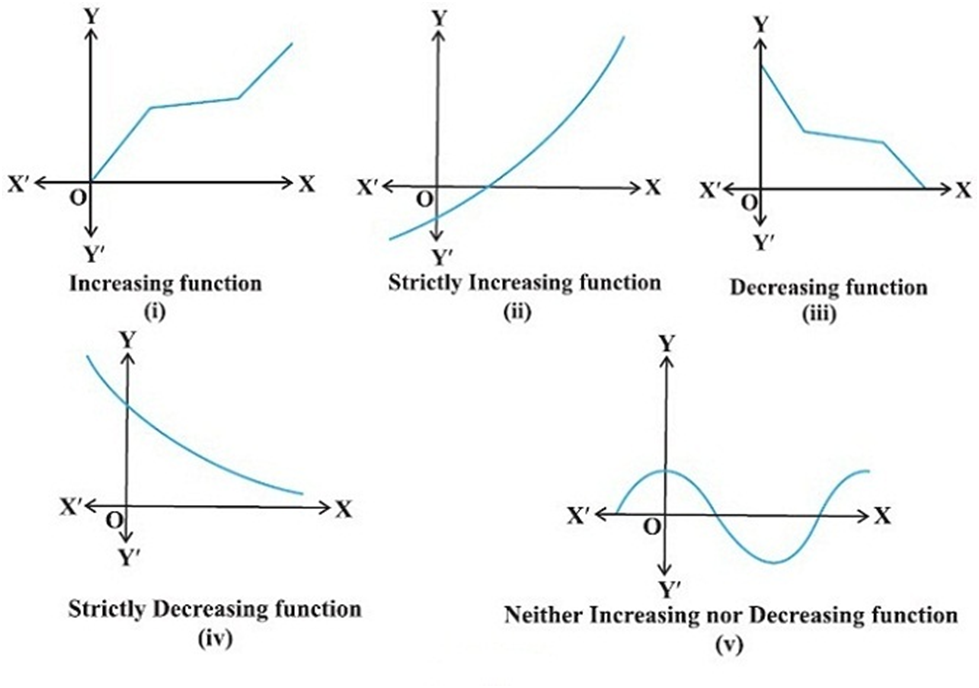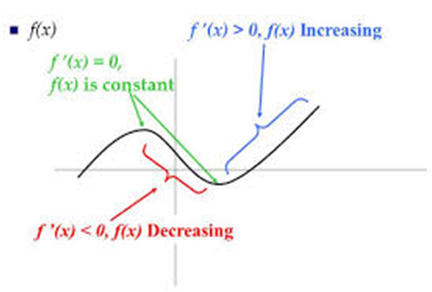- Books Name
- Mathmatics Book Based on NCERT
- Publication
- KRISHNA PUBLICATIONS
- Course
- CBSE Class 12
- Subject
- Mathmatics
Increasing and Decreasing Functions:
Definition : Let I be an interval contained in the domain of a real valued function f.
Then f is said to be
- increasing on I if x1 < x2 in I ⇒f(x1 ) < f(x2 ) for all x1 , x2 ∈ I.
(ii) decreasing on I, if x 1 , x 2 in I ⇒f(x 1 ) < f(x 2 ) for all x 1 , x 2 ∈ I.
- constant on I, if f(x) = c for all x ∈ I, where c is a constant.
(iv) decreasing on I if x1 < x2 in I ⇒ f (x1 ) ≥ f(x2 ) for all x1 , x2 ∈ I.
- strictly decreasing on I if x1 < x2 in I ⇒ f(x1 ) > f(x2 ) for all x1 , x2 ∈ I.

Definition :
Let x 0 be a point in the domain of definition of a real valued function f. Then f is said to be increasing, decreasing at x0 if there exists an open interval I containing x 0 such that f is increasing, decreasing, respectively, in I

Example :
Show that the function given by f(x) = 7x – 3 is increasing on R.
Solution:
Let x1 and x Î R. Then x1 < x2 ⇒ 7x1 < 7x2 ⇒ 7x1 – 3 < 7x2 – 3 ⇒ f(x1 ) < f(x2 ) Thus, by Definition ,
it follows that f is strictly increasing on R.
Theorem 1 :
Let f be continuous on [a, b] and differentiable on the open interval (a,b).
Then (a) f is increasing in [a,b] if f ′(x) > 0 for each x ∈ (a, b)
(b) f is decreasing in [a,b] if f ′(x) < 0 for each x ∈ (a, b)
(c) f is a constant function in [a,b] if f ′(x) = 0 for each x ∈ (a, b)
Proof :
- Let x1 , x2 ∈ [a, b] be such that x1 < x2 . Then, by Mean Value Theorem ,
there exists a point c between x1 and x2
such that f(x2 ) – f(x1 ) = f ′(c) (x2 – x1 )
i.e. f(x2 ) – f(x1 ) > 0 (as f ′(c) > 0 (given))
i.e. f(x2 ) > f(x1 )
Thus, we have x1< x2 =>f (x1 )<f (x2 ), for all x1,x2Î [ a,b ]
Hence, f is an increasing function in [a,b].
The proofs of part (b) and (c) are similar
Example :
Find the intervals in which the function f given by f(x) = x 2 – 4x + 6 is
- increasing (b) decreasing
Solution :
We have f (x) = x 2 – 4x + 6
or f ′(x) = 2x – 4
Therefore, f ′(x) = 0 gives x = 2.
Now the point x = 2 divides the real line into two disjoint intervals namely, (– ∞, 2) and (2, ∞)
In the interval (– ∞, 2), f ′(x) = 2x – 4 < 0.
Therefore, f is decreasing in this interval. Also, in the interval (2, ∞) , f ′(x )> 0
and so the function f is increasing in this interval.
Example :
Find the intervals in which the function f given by f (x) = 4x 3 – 6x 2 – 72x + 30 is
- increasing (b) decreasing.
Solution: We have f(x) = 4x 3 – 6x 2 – 72x + 30
or f ′(x) = 12x 2 – 12x – 72
= 12(x 2 – x – 6) = 12(x – 3) (x + 2)
Therefore, f ′(x) = 0 gives x = – 2, 3.
The points x = – 2 and x = 3 divides the real line into three disjoint intervals, namely,
(– ∞, – 2), (– 2, 3)
and (3, ∞).
In the intervals (– ∞, – 2) and (3, ∞), f ′(x) is positive while in the interval (– 2, 3), f ′(x) is negative. Consequently, the function f is increasing in the intervals (– ∞, – 2) and (3, ∞) while the function is decreasing in the interval (– 2, 3).
However, f is neither increasing nor decreasing in R.


 KRISHNA PUBLICATIONS
KRISHNA PUBLICATIONS
